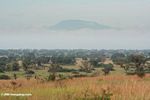Rainforests in South America have endured three previous extreme global warming events in the past, suggesting they will survive a projected 2-6 degree rise in temperatures over the coming century, reports a study published in the Annual Review of Earth and Planetary Science.
The research, published by Carlos Jaramillo and Andrés Cárdenas of the Smithsonian Tropical Research Institute (STRI) in Panama, reviewed some 3,800 published estimates of temperature over the past 120 million years and compared them to the existence of tropical plants in the fossil record. They found that tropical rainforest plant diversity actually increased during previous global warming episodes, including the mid-Cretaceous period 120 million years ago when temperatures in the South American tropics rose 9-12 degrees (5-7°C), the Paleocene-Eocene thermal maximum 55 million years ago when tropical temperatures rose by 5-9 degrees (3-5°C) in less than 10,000 years, and another period of warming 53 million years ago.
Jaramillo and Cárdenas said that a concern raised by other tropical researchers — that increased incidence of drought in the tropics will be detrimental to tropical forests — may be overblown, citing research by STRI scientist Klaus Winter that some tropical trees can endure short-term exposure to temperatures up to 122-127 degrees (50-53°C). The researchers added that trees use less water when CO2 concentrations increase.
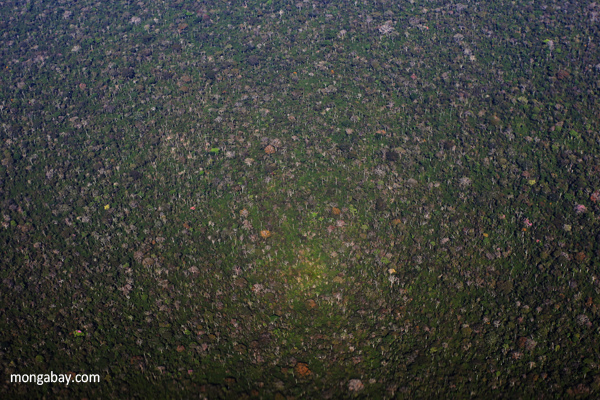
Amazon rainforest.
Jaramillo and Cárdenas paint a far rosier picture than some other researchers working in the region. Studies based on climate model suggest that large extents of the Southern Amazon could be increasingly vulnerable to die-off from severe droughts driven by rising temperatures in the tropical Atlantic Ocean and worsened by large-scale deforestation. Although rainfall appears to be on the rise in the Western Amazon, the Southern Amazon has seen the two worst droughts on record during the past decade. A study published last December showed that trees across large blocks of the Amazon are failing to recover as expected after extended dry periods.
“If droughts continue to occur at 5–10-year frequency, or increase in frequency, large areas of Amazonian forest canopy likely will be exposed to the persistent effect of droughts and the slow recovery of forest canopy structure and function,” wrote Sassan Saatchi and colleagues in the journal Proceedings of the National Academy of Sciences. “In particular, areas of south and western Amazonia have been shown to be affected severely by increasing rainfall variability in the past decade, suggesting that this region may be witnessing the first signs of potential large-scale degradation of Amazonian rainforest from climate change.”

Amazon rainforest.
That concern has been echoed by a series of studies published by Daniel Nepstad of the International Program of the Amazon Environmental Research Institute, which suggests that more than half the Amazon could be destroyed or degraded by 2030 should current trends of deforestation and drought hold.
The dramatically differing scenarios throw into question forecasts about how much carbon South American forests are likely to store in the future and the role these ecosystems may play in exacerbating or mitigation climate change. The Amazon rainforest is estimated to store 80-120 billion tons of carbon at present, or up to 13 years’ worth of carbon emissions at current rates.
Deforestation in the non-Brazilian Amazon |
Deforestation in the Brazilian Amazon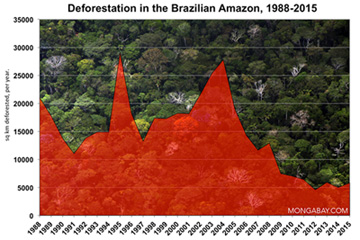 |
CITATIONS:
- Jaramillo, C., Cardenas, A. 2013 Global warming and neotropical rainforests: a historical perspective. Annual Review of Earth and Planetary Sciences Volume 41
- Sassan Saatchi et al. “Persistent effects of a severe drought on Amazonian forest canopy”. PNAS Dec 28, 2012 http://www.pnas.org/cgi/doi/10.1073/pnas.1204651110
- Phillips, O.L. (6 MARCH 2009) Drought Sensitivity of the Amazon Rainforest. SCIENCE 323: 1344-1347
- Daniel C. Nepstad, Claudia M. Stickler, Britaldo Soares- Filho and Frank Merry (2008). Interactions among Amazon land use, forests and climate: prospects for a near-term forest tipping point
Related articles
Amazon’s flood/drought cycle becoming more extreme, less predictable

(05/14/2013) The Amazon River’s hydrological cycle has become more extreme over the past two decades with increasing seasonal precipitation across much of the basin despite drier conditions in the southern parts of Earth’s largest rainforest, finds a new study published in Geophysical Research Letters. The research analyzed monthly Amazon River discharge at Óbidos, a point that drains 77 percent of the Amazon Basin, and compared it with regional precipitation patterns.
Rainforests may be more resilient to global warming – in isolation – than previously forecast
(03/11/2013) Tropical forests may be less sensitive to global warming than previously thought, argues a new study published in Nature Geoscience.
Rate of tree die-off in Amazon higher than conventionally believed
(02/01/2013) The rate of tree mortality in the Amazon rainforest due to storm damage and drought is 9-17 percent higher than conventionally believed, reports a study published in the Proceedings of the National Academy of Sciences (PNAS).
Amazon rainforest failing to recover after droughts
(12/24/2012) The impact of a major drought in the Amazon rainforest in 2005 persisted far longer than previously believed, raising questions about the world’s largest tropical forest to cope with the expected impacts of climate change, reports a new study published in the journal Proceedings of the National Academy of Sciences.
Advanced technology reveals massive tree die-off in remote, unexplored parts of the Amazon

(12/12/2012) Severe drought conditions in 2010 appear to have substantially increased tree mortality in the Western Amazon, a region thought largely immune from the worst effects of changes occurring in other parts of the world’s largest rainforest, reported research presented last week at the fall meeting of the American Geophysical Union (AGU). The findings suggest that the Amazon may face higher-the-expected vulnerability to climate change, potentially undercutting its ability to help mitigate greenhouse gas emissions by absorbing carbon dioxide through faster growth.
Forests worldwide near tipping-point from drought

(11/23/2012) Forests worldwide are at ‘equally high risk’ to die-off from drought conditions, warns a new study published this week in the journal Nature. The study, conducted by an international team of scientists, assessed the specific physiological effects of drought on 226 tree species at 81 sites in different biomes around the world. It found that 70 percent of the species sampled are particularly vulnerable to reduction in water availability. With drought conditions increasing around the globe due to climate change and deforestation, the research suggests large swathes of the world’s forests — and the services they afford — may be approaching a tipping point.
Scientists slam Telegraph blogger’s claims that climate change will be good for the Amazon
(07/12/2012) Recent blog posts on The Telegraph and the Register claiming that tropical rainforests like the Amazon are set to benefit from climate change are ‘uninformed’ and ‘ridiculous’ according to some of the world’s most eminent tropical forest scientists. The posts, published Sunday and Monday by Tim Worstall, a Senior Fellow at London’s Adam Smith Institute, asserted that a new Nature study indicates that ‘climate change will mean new and larger tropical forests.’ But some of the world’s leading tropical forest experts took aim at Worstall’s logic, noting the limitations of the study as well as the other factors that are endangering rainforests.
Deforestation, climate change threaten the ecological resilience of the Amazon rainforest
(01/19/2012) The combination of deforestation, forest degradation, and the effects of climate change are weakening the resilience of the Amazon rainforest ecosystem, potentially leading to loss of carbon storage and changes in rainfall patterns and river discharge, finds a comprehensive review published in the journal Nature.
2010 Amazon drought released more carbon than India’s annual emissions
(10/09/2011) The 2010 drought that affected much of the Amazon rainforest triggered the release of nearly 500 million tons of carbon (1.8 billion tons of carbon dioxide) into the atmosphere, or more than the total emissions from deforestation in the region over the period, estimates a new study published in the journal Environmental Research Letters.
Climate change and deforestation pose risk to Amazon rainforest

(05/20/2011) Deforestation and climate change will likely decimate much of the Amazon rainforest, says a new study by Brazil’s National Institute for Space Research (INPE) and the UK’s Met Office Hadley Centre. Climate change and widespread deforestation is expected to cause warmer and drier conditions overall, reducing the resistance of the rainforest ecosystem to natural and human-caused stressors while increasing the frequency of extreme rainfall events and droughts by the end of this century. While climate models show that higher temperatures resulting from global climate change will threaten the resilience of the Amazon, current deforestation is an immediate concern to the rainforest ecosystem and is likely driving regional changes in climate.
NASA image reveals extent of 2010 Amazon drought
(04/17/2011) NASA has revealed a satellite image of the crippling effect of last year’s record-breaking drought on the Amazon ecosystem. For those of you counting, that’s two record droughts in the Amazon Basin in 5 years.
Last year’s drought hit Amazon hard: nearly a million square miles impacted
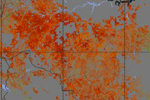
(03/29/2011) A new study on its way to being published shows that the Amazon rainforest suffered greatly from last year’s drought. Employing satellite data and supercomputing technology, researchers have found that the Amazon was likely hit harder by last year’s drought than a recent severe drought from 2005. The droughts have supported predictions by the Intergovernmental Panel on Climate Change’s (IPCC) that climate change, among other impacts, could push portions of the Amazon to grasslands, devastating the world’s greatest rainforest. “The greenness levels of Amazonian vegetation—a measure of its health—decreased dramatically over an area more than three and one-half times the size of Texas and did not recover to normal levels, even after the drought ended in late October 2010,” explains the study’s lead author Liang Xu of Boston University.
Two massive droughts evidence that climate change is ‘playing Russian roulette’ with Amazon
(02/03/2011) In 2005 the Amazon rainforest underwent a massive drought that was labeled a one-in-100 year event. The subsequent die-off of trees from the drought released 5 billion tons of CO2. Just five years later another major drought struck. The 2010 drought, which desiccated entire rivers, may have been even worse according to a new study in Science, adding on-the-ground evidence to fears that climate change may inevitably transform the world’s greatest rainforest.
NASA image reveals worst drought on record for the Amazon river
(12/15/2010) A new image released by NASA reveals the impact of the worst drought on record on the world’s largest river.
Amazon suffers worst drought in decades
(10/24/2010) The worst drought since 1963 has created a regional disaster in the Brazilian Amazon. Severely low water levels have isolated communities dependent on river transport. Given a worsening situation, Brazil announced on Friday an emergency package of $13.5 million for water purification, tents, and food airdrops.
Amazongate fraud
(06/21/2010) The Sunday Times over the weekend retracted a column that accused the Intergovernmental Panel on Climate Change (IPCC) of making a ‘bogus rainforest claim’ when it cited a report warning that up to 40 percent of the Amazon could be “drastically” affected by climate change. The ‘Amazongate’ column, authored by Jonathan Leake, Science & Environment Editor of the Sunday Times, was immediately seized upon by climate skeptics as further evidence to discredit the IPCC just two weeks after it was found to be using shoddy glacier data in its 2007 climate assessment. But now the Sunday Times has removed Leake’s column from its web site and issued on apology, admitting that the Amazon claim was indeed supported by scientific research. The Sunday Times also acknowledged misconduct in the way one of the story’s sources—Simon Lewis of the University of Leeds in Britain—was quoted.
Emissions from Amazon deforestation to rise as loggers move deeper into the rainforest
(07/31/2009) Emissions from Amazon deforestation are growing as developers move deeper into old-growth forest areas where carbon density is higher, report scientists writing in Geophysical Research Letters.
Drought threatens the Amazon rainforest as a carbon sink

(03/05/2009) Drought in the Amazon is imperiling the rainforest ecosystem and global climate, reports new research published in Science. Analyzing the impact of the severe Amazon drought of 2005, a team of 68 researchers across 13 countries found evidence that rainfall-starved tropical forests lose massive amounts of carbon due to reduced plant growth and dying trees. The 2005 drought — triggered by warming in the tropical North Atlantic rather than el Niño — resulted in a net flux of 5 billion tons of carbon dioxide (CO2) into the atmosphere — more than the combined annual emissions of Japan and Europe — relative to normal years when the Amazon is a net sink for 2 billion tons of CO2.
Future threats to the Amazon rainforest
(07/31/2008) Between June 2000 and June 2008, more than 150,000 square kilometers of rainforest were cleared in the Brazilian Amazon. While deforestation rates have slowed since 2004, forest loss is expected to continue for the foreseeable future. This is a look at past, current and potential future drivers of deforestation in the Brazilian Amazon.
Half the Amazon rainforest will be lost within 20 years
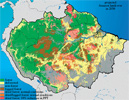
(02/27/2008) More than half the Amazon rainforest will be damaged or destroyed within 20 years if deforestation, forest fires, and climate trends continue apace, warns a study published in Philosophical Transactions of the Royal Society B. Reviewing recent trends in economic, ecological and climatic processes in Amazonia, Daniel Nepstad and colleagues forecast that 55 percent of Amazon forests will be “cleared, logged, damaged by drought, or burned” in the next 20 years. The damage will release 15-26 billion tons of carbon into the atmosphere, adding to a feedback cycle that will worsen both warming and forest degradation in the region. While the projections are bleak, the authors are hopeful that emerging trends could reduce the likelihood of a near-term die-back. These include the growing concern in commodity markets on the environmental performance of ranchers and farmers; greater investment in fire control mechanisms among owners of fire-sensitive investments; emergence of a carbon market for forest-based offsets; and the establishment of protected areas in regions where development is fast-expanding.
Amazon rainfall linked to Atlantic Ocean temperature
(02/25/2008) Climate models increasingly forecast a dire future for the Amazon rainforest. These projections are partly based on recent research that has linked drought in the Amazon to sea surface temperatures in the tropical Atlantic. As the tropical Atlantic warms, the southern Amazon — the agricultural heartland of Brazil — may see higher temperatures and less rainfall.
Global warming – not el Nino – drove severe Amazon drought in 2005
(02/20/2008) One of the worst droughts on record in the Amazon was caused by high temperatures in the Atlantic rather than el Nino. The research, published in Philosophical Transactions of the Royal Society B, suggests that human-driven warming is already affecting the climate of Earth’s largest rainforest.
Fire policy is key to reducing the impact of drought on the Amazon
(02/19/2008) Gaining control over the setting of fires for land-clearing in the Amazon is key to reducing deforestation and the impact of severe drought on the region’s forests, write researchers in a paper published in Philosophical Transactions of the Royal Society B.
55% of the Amazon may be lost by 2030
(01/23/2008) Cattle ranching, industrial soy farming, and logging are three of the leading drivers of deforestation in the Brazilian Amazon. As commodity prices continue to rise, driven by surging demand for biofuels and grain for meat production, the economic incentives for developing the Amazon increase. Already the largest exporter of beef and the second largest producer of soy – with the largest expanse of “undeveloped” but arable land of any country – Brazil is well on its way to rivaling the U.S. as the world’s agricultural superpower. The trend towards turning the Amazon into a giant breadbasket seems unstoppable. Nevertheless the decision at the U.N. climate talks in Bali to include “Reducing Emissions From Deforestation and Degradation” (REDD) in future climate treaty negotiations may preempt this fate, says Dr. Daniel Nepstad, a scientist at the Woods Hole Research Institute.
Global warming accelerates destruction of the Amazon
(12/06/2007) Deforestation and climate change could damage or destroy as much as 60 percent of the Amazon rainforest by 2030, according to a new report from environmental group WWF. The report, The Amazon’s Vicious Cycles: Drought and Fire in the Greenhouse, shows that degradation in the Amazon could release 55-97 million tons of carbon dioxide by 2030. Forest loss could also dramatically impact water cycles in the region, affecting rainfall that is critical for river flows and agriculture.
Subtle threats could ruin the Amazon rainforest

(11/07/2007) While the mention of Amazon destruction usually conjures up images of vast stretches of felled and burned rainforest trees, cattle ranches, and vast soybean farms, some of the biggest threats to the Amazon rainforest are barely perceptible from above. Selective logging — which opens up the forest canopy and allows winds and sunlight to dry leaf litter on the forest floor — and 6-inch high “surface” fires are turning parts of the Amazon into a tinderbox, putting the world’s largest rainforest at risk of ever-more severe forest fires. At the same time, market-driven hunting is impoverishing some areas of seed dispersers and predators, making it more difficult for forests to recover. Climate change — an its forecast impacts on the Amazon basin — further looms large over the horizon.
Globalization could save the Amazon rainforest
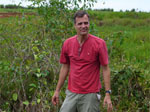
(06/03/2007) The Amazon basin is home to the world’s largest rainforest, an ecosystem that supports perhaps 30 percent of the world’s terrestrial species, stores vast amounts of carbon, and exerts considerable influence on global weather patterns and climate. Few would dispute that it is one of the planet’s most important landscapes. Despite its scale, the Amazon is also one of the fastest changing ecosystems, largely as a result of human activities, including deforestation, forest fires, and, increasingly, climate change. Few people understand these impacts better than Dr. Daniel Nepstad, one of the world’s foremost experts on the Amazon rainforest. Now head of the Woods Hole Research Center’s Amazon program in Belem, Brazil, Nepstad has spent more than 23 years in the Amazon, studying subjects ranging from forest fires and forest management policy to sustainable development. Nepstad says the Amazon is presently at a point unlike any he’s ever seen, one where there are unparalleled risks and opportunities. While he’s hopeful about some of the trends, he knows the Amazon faces difficult and immediate challenges.
